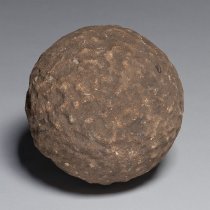Object Record
Images

Metadata
Catalog Number |
2009.23 |
Object Name |
Cannonball |
Title |
Cannonball |
Artist |
Unknown |
Description |
Stone cannonball, 7 inches in diameter. Surface is pockmarked. |
Label |
When APS member W. H. Robertson presented this stone cannonball to the APS in 1837, he claimed that it had been fired at Mary, Queen of Scots, as she escaped from Loch Leven Castle in 1568. The Scottish nobility had imprisoned Mary there in 1567 following her hasty, ill-advised third marriage. The nobles eventually forced her to abdicate in favor of her young son James VI. She spent the next two decades in the custody of her cousin Queen Elizabeth I in England, but her constant plotting to regain her throne and depose Elizabeth led to her execution for treason in 1587. By the 19th century, Mary had become a tragic figure of romance, particularly among the Scots. Robertson acquired this cannonball from an “old Fisherman” in Scotland who claimed that historian and novelist Sir Walter Scott told him where to find the balls that had been fired at the fleeing queen. Robertson related that 22 cannonballs had been discovered at the bottom of the loch; 21 were at the Society of Antiquaries of Scotland, while Robertson claimed the 22nd for Philadelphia. Relics related to famous people were popular collectors’ items in the at the time, and the Scottish fisherman may have simply been selling what buyers wanted – curiosities with grand if improbable histories. The 21 cannonballs supposedly given to the Scottish antiquarian society do not appear in the organization's list of donations, and, in fact, the cannons used to attack Mary were not even capable of shooting a missile as large as this one. While this ball is likely an authentic relic of some past event, what precisely it represents remains a mystery. |
Material |
Stone |
Dimensions |
Cir-24 inches |
Credit line |
American Philosophical Society. Gift of W. H. Robertson, 6 October 1837. |
Search Terms |
16th century sixteenth century weapon war Scotland England |
